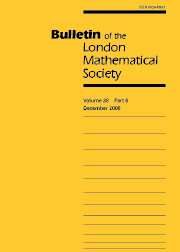Article contents
LINK COBORDISM AND THE INTERSECTION OF SLICE DISCS
Published online by Cambridge University Press: 01 November 1999
Abstract
We work in the smooth category.
An (oriented) (ordered) m-component n-(dimensional) link is a smooth oriented submanifold L = {K1, …, Km} of Sn+2 which is the ordered disjoint union of m manifolds, each PL-homeomorphic to the standard n-sphere. If m = 1, then L is called a knot.
We say that m-component n-dimensional links L0 and L1 are (link-)concordant or (link-)cobordant if there is a smooth oriented submanifold C˜ = {C1, …, Cm} of Sn+2 × [0, 1] which meets the boundary transversely in ∂C˜, is PL-homeomorphic to L0 × [0, 1], and meets Sn+2 × {l} in Ll (l = 0, 1). If m = 1, then we say that n-knots L0 and Ll are (knot-)concordant or (knot-)cobordant. Then we call C a concordance-cylinder of the two n-knots L0 and Ll.
If an n-link L is concordant to the trivial link, then we call L a slice link.
If an n-link L = {K1, …, Km} ⊂ Sn+2 = ∂Bn+3 ⊂ Bn+3 is slice, then there is a disjoint union of (n + 1)-discs Dn+11 [amalg ] … [amalg ] Dn+1m in Bn+3 such that Dn+1i ∩ Sn+2 = ∂Dn+1i = Ki. (Dn+11, …, Dn+1m) is called a set of slice discs for L. If m = 1, then Dn+11 is called a slice disc for the knot L.
- Type
- NOTES AND PAPERS
- Information
- Copyright
- © The London Mathematical Society 1999
- 1
- Cited by




